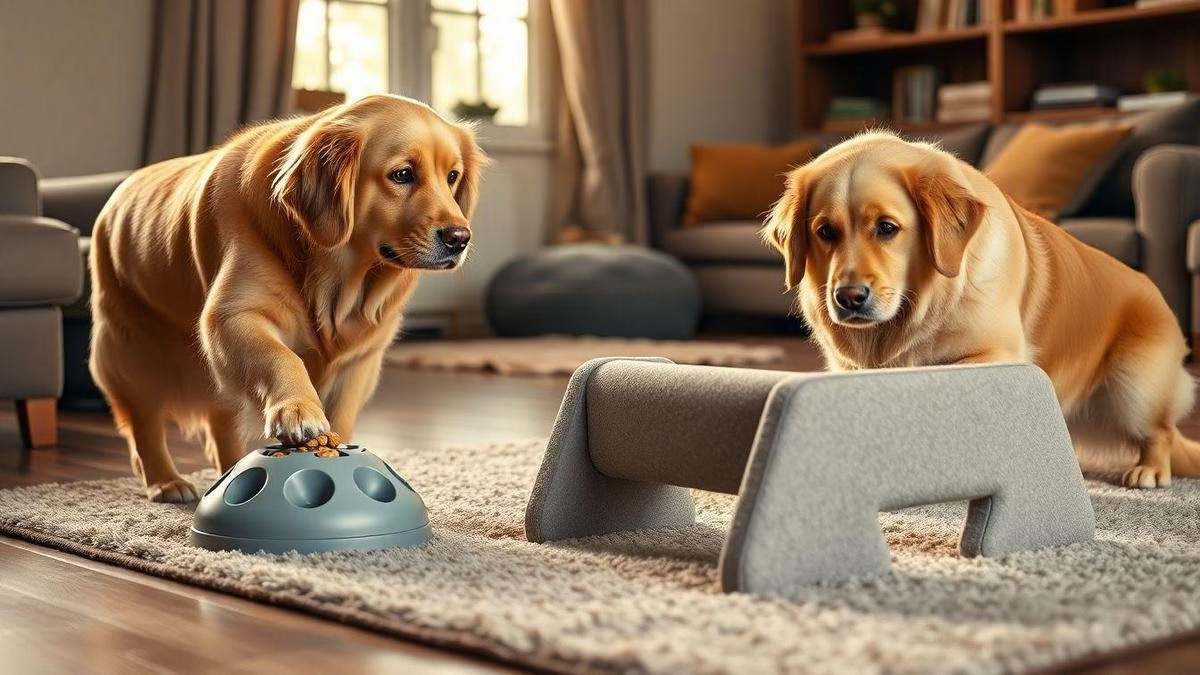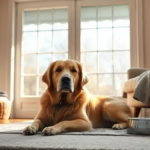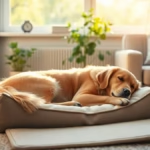Indoor Training Games for Senior Golden Retrievers are my go‑to for low‑impact fun and brain work. I choose gentle mobility and balance moves on soft surfaces, keep sessions short, and rotate puzzle toys to spark interest. I teach simple scent games, add gentle obedience with a clicker, and follow my vet for rehab. I watch for happy signs and tweak games as my dog’s needs change.
Key Takeaway
- I use short, gentle games to protect my older Golden’s joints.
- I choose slow, low‑impact activities like nose work and soft fetch. See ideas for low‑impact exercises for Goldens with arthritis.
- I reward with soft treats and happy praise to keep my dog calm; positive reinforcement really helps.
- I keep sessions brief and watch for signs of tiredness.
- I change games to match my dog’s mobility and comfort, guided by gentle training principles in gentle senior training methods.
How I use Indoor Training Games for Senior Golden Retrievers to support low‑impact indoor exercises
I started using Indoor Training Games for Senior Golden Retrievers when my old boy, Buddy, slowed down. Games gave me a way to add gentle motion and bright spots in his day. A quick scent game or a soft fetch session gets his brain and body working without long walks that tire his joints.
I mix short games with small exercise goals. For example, I hide a treat under a towel and ask him to nose it out, then follow with two sit‑to‑stand reps. That combo keeps his muscles active and his mind sharp. I use low‑value treats to avoid overfeeding and change toys so he stays curious—see my notes on appropriate toys to stimulate senior Goldens.
I watch him closely and stop at the first sign of stiffness or limp. I also check with our vet about new moves. These games help his mood and make daily care easier—grooming, light stretching, or taking medicine become calmer when he’s relaxed from play. For more mental ideas, I refer to mental enrichment activities for senior Goldens.
Low‑impact indoor exercises for senior Golden Retrievers I choose
I pick exercises that move joints gently: short leash walks through the house, sit‑to‑stand repetitions, and slow indoor fetch on carpet. Food puzzle toys encourage gentle paw and neck movement. Each choice targets a small range of motion to keep him steady without strain.
Before I start, I run a quick safety check:
- Check paws for cuts and room for tripping.
- Warm his muscles with 1–2 minutes of slow stroking.
- Use a non‑slip surface.
- Keep sessions under 10 minutes and stop if he shows pain.
When he’s tired or stiff, I swap motion for scent work or quiet touch. This keeps the routine flexible and respects his energy. For structured ideas that fit into daily life, I follow suggestions from gentle daily activities to support senior Goldens.
Mobility and balance exercises for senior Golden Retrievers I practice
I use gentle balance drills: stepping over low poles, slow figure‑eight walks around cushions, and target touching where he noses my hand or a small cone. I do these with lots of praise and tiny treats. The goal is slow, controlled movement that builds confidence and steadies his steps.
Progress is tiny and patient. If he wobbles, I back up and reward small wins. I include brief massage and passive range‑of‑motion moves after the work to relax muscles. When he improves, I add one small challenge—shorter time between targets or a slightly higher paw‑up—but never push past comfort.
| Exercise | Benefit | Typical Time | Best Surface |
|---|---|---|---|
| Nose work (treats hidden) | Mental mild neck movement | 3–5 min | Rug or carpet |
| Sit‑to‑stand reps | Hip and core strength | 2–4 min | Non‑slip mat |
| Low pole step‑overs | Balance and coordination | 3–5 min | Carpet with yoga mat |
If your dog has diagnosed joint issues, consider tailored plans like those discussed in low‑impact exercises for Goldens with arthritis.
Short sessions and soft surfaces I prefer
I keep sessions 3–8 minutes and do several small sessions a day. Soft rugs or a yoga mat let his paws grip and prevent slipping. Short bursts let him try without getting sore, and the soft surface feels like a cozy stage for his little performances.
How I add mental stimulation with puzzle toys
I changed how I play with Buddy when his pace slowed. Short, gentle sessions make his brain work without tiring his joints. I set up little challenges on the floor or a low table so he can use his nose and paws without jumping or climbing.
If his teeth are sore, I give softer treat puzzles. If his sight is lower, I use toys that make noise or carry a strong scent. I stop when he seems bored or tired—keeping play positive and fun instead of frustrating. For toy suggestions and how to match difficulty, see appropriate toys to stimulate senior Goldens.
Indoor Training Games for Senior Golden Retrievers fit well into this rhythm and keep his days bright. For broader ideas on keeping a senior Golden’s mind active, I like the tips in how to keep your senior Golden’s mind active.
Puzzle toys for senior Golden Retrievers I recommend
I rely on a few go‑to toys Buddy loved: soft treat‑dispensing toys you can stuff with wet food, snuffle mats for slow sniff work, and low‑effort puzzle boards with sliding pieces for dogs with steadier paws.
| Toy type | Difficulty | Why I like it |
|---|---|---|
| Soft KONG‑style (stuffable) | Low | Gentle on teeth, fills with soft food |
| Snuffle mat | Low | Encourages sniffing, calming and slow |
| Sliding puzzle board | Medium | Moves with paw, boosts problem‑solving |
| Slow‑wobble feeder | Low–Med | Encourages slow eating and paw nudges |
I clean and rotate toys often. Size matters—pick pieces that fit his mouth so he can grab them without strain. When a toy frustrates him, I step it down. For more product ideas and selection tips, check appropriate toys to stimulate senior Goldens.
Mental stimulation activities I use indoors
Short scent games and simple hide‑and‑seek are staples. I hide small treats under cups or inside a folded towel and let him find them. I also teach tiny tricks—touch, slow spin, or place—with lots of praise. These are low impact but make him think and follow cues.
Indoor Training Games for Senior Golden Retrievers I rotate for variety:
- Shell game: hide a treat under one of three cups and shuffle slowly.
- Sniff trail: drag a treat trail around a room for him to follow.
- Puzzle mat session: scatter kibble in the mat for calm foraging.
- Short cue practice: five reps of sit, name, or paw with breaks.
- Gentle tug or fetch with a soft toy on the floor, low energy.
I keep sessions to 5–10 minutes, twice a day. If he’s stiff after play, I follow with a warm spot and a gentle massage. For more structured mental enrichment ideas, see mental enrichment activities for senior Goldens.
Rotating toys to keep interest
I swap toys every few days and reintroduce an old favorite like a novel item. Rotation turns familiar objects into new puzzles. I keep a small box of toys and change two items each day; this keeps him curious without overwhelming him.
I teach indoor scent games to engage their nose
Scent games light Buddy up. After years of walks and fetch, his nose still rules. Scent games give him something gentle and fun to do when long walks aren’t possible. I set up short sessions (5–10 minutes), several times a day, so he doesn’t tire his joints.
I keep the room calm and clutter‑free, move slowly, talk softly, and let him lead the search. If he’s stiff or tired, I bring the game to a chair or couch so he can stay comfy. These Indoor Training Games for Senior Golden Retrievers cut boredom, lower restlessness, and often spark a wag. For ideas on creating calm training spaces, I reference creating calm and peaceful environments.
Indoor scent games I start with
- Cup switch — hide, shuffle slowly, reward when found.
- Muffin tin — cover some holes to add a sniff puzzle.
- Pillow search — low hiding places, big payoff for small effort.
| Game | Setup time | Physical demand | Mental benefit |
|---|---|---|---|
| Cup switch | 1–2 minutes | Low | Focus & choice‑making |
| Muffin tin | 2–3 minutes | Low | Problem solving |
| Pillow search | 1–2 minutes | Very low | Confidence & exploration |
Using treats and safe scents indoors
I pick small, soft treats so he can eat quickly and not strain his teeth. I rotate smells—cheese, cooked chicken, a dab of vanilla on a cotton ball—to keep interest high without using anything irritating. I avoid raw spices or essential oils and always watch for sneezes or upset tummies. If hearing or vision declines, I adapt with noisier or stronger‑scented cues as explained in how to deal with hearing loss and vision problems in aging Goldens.
I use gentle obedience and clicker training techniques
I blend calm, slow obedience work with clicker games because Buddy slowed down but stayed sharp. I traded speed for clarity: short sessions, soft voice, and clear cues kept him engaged without tiring his joints. For step‑by‑step methods, I follow guidelines in how to train your senior Golden and the patient approach in gentle senior training methods.
Indoor Training Games for Senior Golden Retrievers like hide‑and‑seek with treats, scent boxes, and low‑step target work kept his brain busy and cut down on anxious pacing. I rotate rewards—soft kibble, a favorite chew, or a gentle rub—so training feels fresh.
Gentle obedience in short steps I follow
- Start in a calm room with one handler.
- Use a soft cue and show the action slowly.
- Reward within one second of the correct response.
- Pause after two to three reps and end on a success.
- Repeat twice a day for 5–7 minutes each.
I watch body language closely—stiff hips, slow rises, or long looks at the door mean more rest or lower impact. For behavior technique ideas that work well with seniors, see top behavior training techniques for senior Goldens.
Clicker training techniques that helped me
The clicker marks tiny wins. For a senior dog, that clarity cuts confusion. I started with simple target touches, then shaped longer behaviors like stepping onto a low platform to help balance. Clicker work let me build behaviors in very small steps.
| Command | Low‑impact version | Why it helps |
|---|---|---|
| Sit | Gentle sit from standing with hand guide | Reduces hip stress |
| Down | Soft down onto a foam mat | Cushions joints |
| Recall | Short indoor recalls with treats | Builds confidence without long runs |
I click and treat immediately so he links action and reward. I favor low‑impact commands like place, touch, and step up to keep joints safe while giving mental lift.
I plan adaptive training and rehabilitation with vet guidance
I always start with a vet check. Buddy had arthritis and a wobble in his hind legs, so we reviewed meds, pain levels, and limits before changing his routine. That medical picture shaped every choice—from session length to toy selection.
From that baseline, I set small, visible goals with a vet and, when possible, a canine rehab therapist. Short sessions focused on strength, balance, and confidence. I kept rehab playful by turning parts into Indoor Training Games for Senior Golden Retrievers: quiet space, non‑slip rugs, and soft ramps made rehab feel like fun. For rehab exercises and adaptations, I drew on gentle daily activity guidance and the low‑impact exercise approaches.
Adaptive training and rehab I coordinated
We began with five‑minute walks and simple sit‑to‑stand drills using treats and praise. The therapist taught me to watch for pain signals—short whines, quick stops, or favoring a leg—and we adapted immediately. Progress was slow but steady.
Home changes included a ramp to the couch, lower bowls, and a supportive bed. With the vet’s go‑ahead we added hydrotherapy once a week, which helped his hips and mood. For ideas on creating comfort at home, I used tips from creating comfort for senior Goldens.
Mobility and balance exercises I use in rehab
| Exercise | Purpose | Frequency & Duration |
|---|---|---|
| Standing weight shifts | Improve weight distribution | 2–3 sets of 5 reps daily |
| Figure‑eight walks | Enhance turning balance | 5–10 minutes, 3× weekly |
| Low cavaletti poles | Lift stride and coordination | 3 walks over poles, 2–3× weekly |
| Balance disc | Proprioception and core strength | 1–2 minutes, 2 sets, 3× weekly |
| Hydrotherapy | Low‑impact strength and endurance | 20 minutes, once weekly (if vet approves) |
Warm up with a short walk or gentle massage, do the exercises, then cool down with slow petting and a treat.
Tracking progress with gentle goals
I kept goals tiny and kind: add one more step, stand five seconds longer, or complete an extra lap around the cones. I took photos and notes weekly to see real changes. When he paused or tired, I shortened the session and praised him. Little wins added up into calmer walks and brighter eyes. For keeping routines simple and consistent, I reference simple daily care routines.
How I enrich daily life with senior dog enrichment activities using Indoor Training Games for Senior Golden Retrievers
I keep most mental workouts short and playful. Buddy loves a quick brain teaser more than a long run these days. I mix sniff games, simple obedience with soft treats, and slow puzzle feeders. For example, I hide a favorite chew under a towel and cheer when he noses it out. Tiny tricks—touch or paw—use his mind and give him pride.
I space three to four short sessions across the day so he doesn’t get tired. Morning scent work after breakfast, mid‑day puzzle feeding, and a short training game in the afternoon create a predictable routine he looks forward to. For more enrichment routines, see mental enrichment activities and gentle daily activities.
Daily pattern I follow:
- Morning: 5–8 minutes scent game (towel hides)
- Midday: 8–10 minutes puzzle feeder or soft toy activity
- Afternoon: 5 minutes of light obedience or shell game
- Evening: cuddle time and a calm chew or massage
I change toys every few days. If he’s stiff, I cut sessions to one or two short rounds, ending each with praise and a calm reward.
Signs I look for that show my Golden enjoys Indoor Training Games for Senior Golden Retrievers
When Buddy is into a game, he becomes focused and purposeful: leaning forward, little tail wags, bringing the toy back or nudging my hand for more. He’ll also return to the game later on his own—that’s my clearest sign he enjoyed it.
Opposite signs—slow movements, heavy panting, or turning away—mean it’s time to stop. If he lies down and yawns mid‑play, I end the session and offer water and a quiet lap. Reading those cues keeps play fun and safe. If you’re watching for cognitive decline, be aware of changes noted in signs of canine dementia.
Adapting games as health changes
As Buddy ages, I soften everything: lower surfaces, non‑slip mats, softer treats, louder scents for nose work, and shorter rounds. I swap high jumps for easy reach games and noisy toys for quiet ones if joints or hearing change. Small shifts let us keep playing while respecting his body. For real owner stories and routine changes, I found useful guidance in how my senior Golden changed routine and building stronger bonds.
| Game | Main benefit | Easy adaptation for seniors |
|---|---|---|
| Scent hides (towel or cups) | Mental stimulation, gentle movement | Use stronger‑smelling treats, keep cups low, shorter rounds |
| Puzzle feeder | Slows eating, problem solving | Choose low‑effort puzzles, pre‑load half the treats |
| Shell game (treat under cup) | Focus and memory | Use larger cups, sit at his level, fewer repeats |
| Gentle fetch with soft toy | Interactive play, light movement | Roll instead of toss, use plush toy, limit distance |
Conclusion
I keep it simple: short, gentle, and purposeful. I use soft surfaces, puzzle toys, and scent work to give my senior Golden mental sparks without straining his joints. I mix in clicker clarity and follow my vet so every move is safe.
Those tiny, patient steps matter. A five‑minute sniff game or a couple of sit‑to‑stand reps can lift his mood and keep his body steady. Little wins pile up into real difference. Watch cues, adapt the games, and stop at the first sign of discomfort. If you want more ideas to keep senior Goldens happy, start small and be kind—Indoor Training Games for Senior Golden Retrievers truly make days brighter. For more personal experience and encouragement, I often read posts like the journey of aging — an owner’s perspective and everyday joys with my senior Golden.

Rafael Souza is a digital marketing strategist and lifelong dog enthusiast. Passionate about Golden Retrievers, he shares practical, research-based tips to help owners provide healthier and happier lives for their furry companions.





